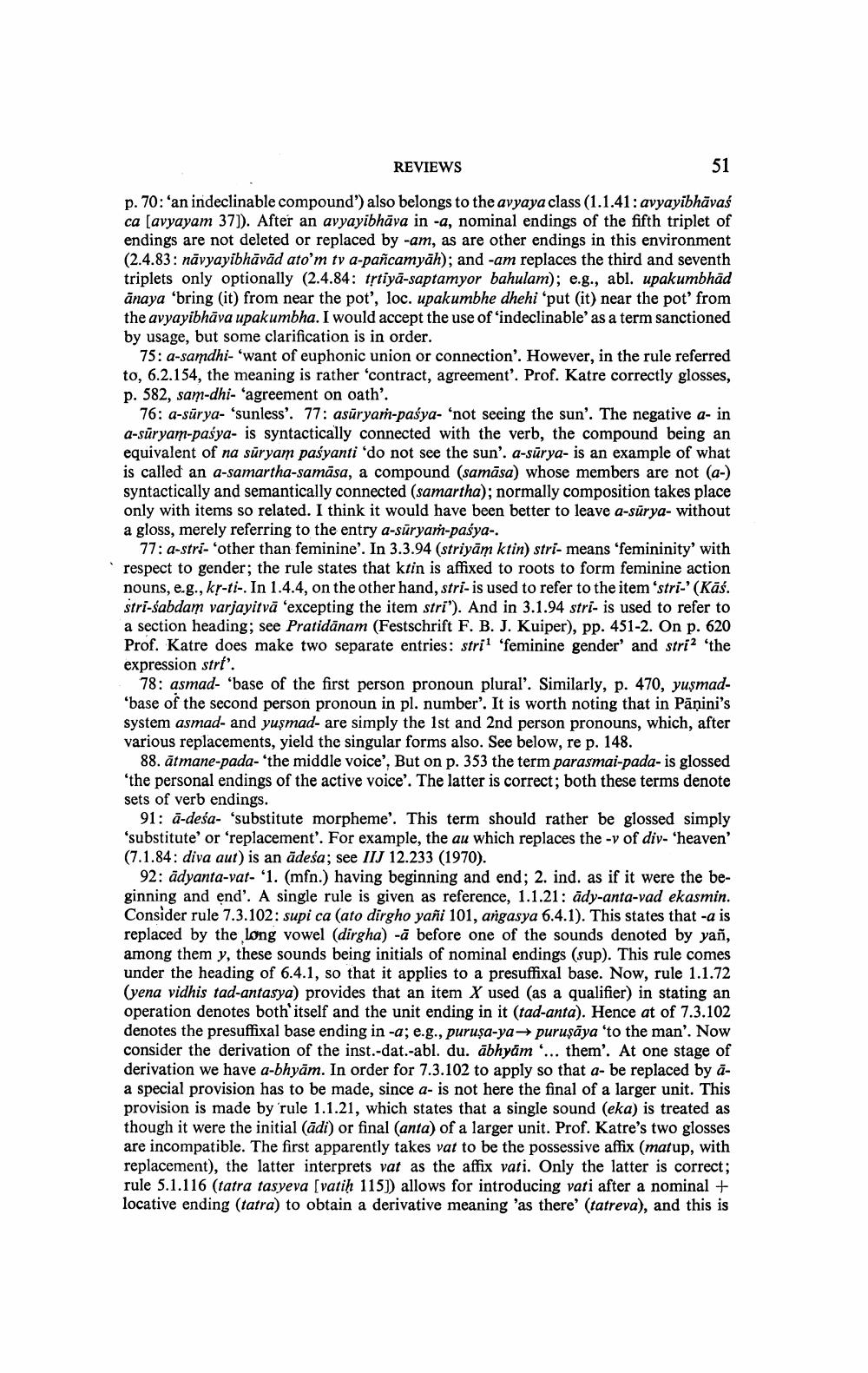Book Title: Reviews Of Different Books Author(s): Publisher: View full book textPage 9
________________ REVIEWS 51 p. 70: 'an indeclinable compound') also belongs to the avyaya class (1.1.41: avyayibhavas ca (avyayam 37]). After an avyayibhava in -a, nominal endings of the fifth triplet of endings are not deleted or replaced by -am, as are other endings in this environment (2.4.83: navyayibhavad ato'm tv a-pancamyah); and -am replaces the third and seventh triplets only optionally (2.4.84: trtiya-saptamyor bahulam); e.g., abl. upakumbhad anaya 'bring (it) from near the pot', loc. upakumbhe dhehi 'put (it) near the pot' from the avyayibhava upakumbha. I would accept the use of 'indeclinable' as a term sanctioned by usage, but some clarification is in order. 75: a-samdhi- 'want of euphonic union or connection'. However, in the rule referred to, 6.2.154, the meaning is rather 'contract, agreement'. Prof. Katre correctly glosses, p. 582, sam-dhi- 'agreement on oath'. 76: a-surya- 'sunless'. 77: asuryam-pasya- 'not seeing the sun'. The negative a- in a-suryam-pasya- is syntactically connected with the verb, the compound being an equivalent of na suryam pasyanti 'do not see the sun'. a-surya- is an example of what is called an a-samartha-samasa, a compound (samasa) whose members are not (a-) syntactically and semantically connected (samartha); normally composition takes place only with items so related. I think it would have been better to leave a-surya- without a gloss, merely referring to the entry a-suryam-pasya-. 77: a-stri- 'other than feminine'. In 3.3.94 (striyam ktin) stri- means 'femininity' with respect to gender; the rule states that ktin is affixed to roots to form feminine action nouns, e.g., kr-ti-. In 1.4.4, on the other hand, stri-is used to refer to the item 'stri-'(Kas. stri-sabdam varjayitva 'excepting the item stri'). And in 3.1.94 stri- is used to refer to a section heading; see Pratidanam (Festschrift F. B. J. Kuiper), pp. 451-2. On p. 620 Prof. Katre does make two separate entries: stri? 'feminine gender and stri2 'the expression stri'. 78: asmad- 'base of the first person pronoun plural'. Similarly, p. 470, yusmad'base of the second person pronoun in pl. number'. It is worth noting that in Panini's system asmad- and yusmad- are simply the 1st and 2nd person pronouns, which, after various replacements, yield the singular forms also. See below, re p. 148. 88. atmane-pada- 'the middle voice', But on p. 353 the term parasmai-pada- is glossed 'the personal endings of the active voice'. The latter is correct; both these terms denote sets of verb endings. 91: a-desa- 'substitute morpheme'. This term should rather be glossed simply 'substitute' or 'replacement'. For example, the au which replaces the -v of div- 'heaven' (7.1.84: diva aut) is an adesa; see IIJ 12.233 (1970). 92: adyanta-vat-'1. (mfn.) having beginning and end; 2. ind. as if it were the beginning and end'. A single rule is given as reference, 1.1.21: ady-anta-vad ekasmin. Consider rule 7.3.102: supi ca (ato dirgho yani 101, angasya 6.4.1). This states that -a is replaced by the long vowel (dirgha) -a before one of the sounds denoted by yan, among them y, these sounds being initials of nominal endings (sup). This rule comes under the heading of 6.4.1, so that it applies to a presuffixal base. Now, rule 1.1.72 (yena vidhis tad-antasya) provides that an item X used (as a qualifier) in stating an operation denotes both itself and the unit ending in it (tad-anta). Hence at of 7.3.102 denotes the presuffixal base ending in -a; e.g., purusa-ya purusaya 'to the man'. Now consider the derivation of the inst.-dat.-abl. du. abhyam ... them'. At one stage of derivation we have a-bhyam. In order for 7.3.102 to apply so that a- be replaced by aa special provision has to be made, since a- is not here the final of a larger unit. This provision is made by 'rule 1.1.21, which states that a single sound (eka) is treated as though it were the initial (adi) or final (anta) of a larger unit. Prof. Katre's two glosses are incompatible. The first apparently takes vat to be the possessive affix (matup, with replacement), the latter interprets vat as the affix vati. Only the latter is correct; rule 5.1.116 (tatra tasyeva (vatih 115]) allows for introducing vati after a nominal + locative ending (tatra) to obtain a derivative meaning 'as there' (tatreva), and this isPage Navigation
1 ... 7 8 9 10 11 12 13 14 15 16 17 18 19 20 21 22 23 24 25 26 27 28 29 30 31 32 33 34 35 36 37 38
